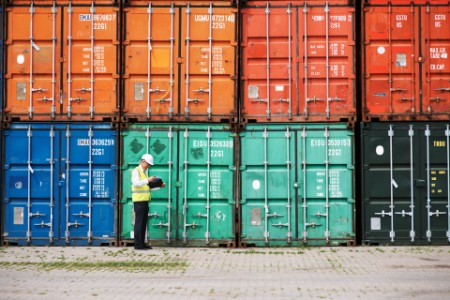By using AI machine learning to handle “process, predict and prescribe” across the enormous amounts of data now available, clients are using their people to add value by delivering insights as decisions are made. In real time.
The client and challenge
The client is a future-focused organization and an advanced technology adopter, applying tech to solve some of their biggest business issues.
They operate one of the world’s largest ports where logistics present an overwhelming challenge. Nearly 100 vessels move in and out every day, each carrying up to 20,000 20-foot containers, requiring giant trucks, cranes and workers with diverse skills to service them. Any miscalculation in a vessel’s arrival time has the potential to create significant delays for the port. When things go wrong, vessels are left without somewhere to dock, workers wait without a job to do and machinery gets bottlenecked.
Helping the client develop an approach to accurately predict vessel movement and from there, better allocate people and machinery was the remit.
The right scope with a team approach
For automation to be successfully embedded in an organization, the leadership and teams involved need to be part of the process.
We assembled a working group that included a mix of EY people and client leaders and team members, across all aspects of their operations to ensure we achieved buy-in and engagement. This was a time-boxed project so we ran a series of design thinking workshops to help confirm the exact areas within the operation to be automated with AI.
This was a highly interactive approach where we were able to narrow down the scope of the project to three specific hypotheses around more accurately predicting vessel movement in and out of port, allocating machinery in real-time and better planning people resources.
Applying AI
Moving AI from the lab to the field is hard and this case study highlights the need to complement AI skills with a deep understanding of the organization’s data and operational context.
Using AI machine learning and new data sources, we helped developed three live solutions with more than 20 AI models built and integrated to predict:
- Vessel arrival 14 days out
- Resources the port would need to meet demand, and
- Potential machinery choke points in the yard.
We used extensive historical databases to inform the machine learning model with variables such as tidal patterns, vessel sizes and past variations in arrival times from different shipping lines. By incorporating this historical data with satellite navigation and each vessel’s declared arrival time, the vessel movement model proved to be materially more accurate than the port operator’s previous system.
More precise arrival times subsequently allowed for more accurate workforce planning; which, in turn, better highlighted potential choke points and allowed for real-time suggestions for faster driving routes through the yard so that machinery was where it needed to be at the right time.
The outcomes so far
Together, these three automated AI solutions significantly increased the port’s efficiency and helped to deliver substantial cost savings. The automated AI solution for vessel movement alone increased accuracy by 3% (beyond the client’s benchmarks) which translated to approximately US$10.2 million in savings in the near term.
In addition to this macro impact for the client, better predictions have meant that workers on the ground now have more predictable work hours, with little down-time during a shift and reduced over-time due to unexpected vessel delays.
Application of any technology needs to resolve real-life problems for businesses, and do so in an inclusive and responsible way. For this client, AI was the right technology to deliver the required outcomes, including improving the working environment of their employees.
Every improvement in the predictive models, no matter how minor, exponentially improves the port’s operation.
And next?
The work we undertook is being incorporated into the client’s plans for a mega-port in the future, where intelligent automation will be at the heart of all operations.
And today, the client sees continuous improvement in the machine learning model’s prediction accuracy with additional data being added all the time. It’s a real-life example of AI automation that becomes more intelligent over time. For further client examples of intelligent automation being achieved through advanced data analytics techniques (like AI), read some of our other articles.
Summary
By using AI machine learning to handle “process, predict and prescribe” across the enormous amounts of data now available, clients are using their people to add value by delivering insights as decisions are made. In real time.
Across a wide range of industries, geographies and business issues, automation remains a key business driver for today and tomorrow.


